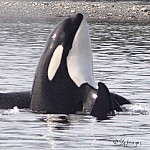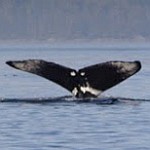If you’ve never seen a whale before, it can be hard to know what to look for. Here are some tips that may help you see and identify them, and what they look like at the surface.
Where to look:
- Scan from left to right, slowly, and then back again. Look close to shore, and look out across the horizon. Watch for anything that breaks the surface of the water.
- Look for boats, especially if they are stopped. Sometimes the best way to find marine mammals is to find the other people who are watching them.
- Is it a log, or is it a whale? Whale-watchers in the Northwest often get fooled by driftwood or logs that look like animals, floating on the surface of the water. But marine mammals are on the move – typically, they will surface, dive, then come up again in a different place. If what you are watching stays on the surface and in the same location for a while…it’s likely not a marine mammal.
What to look for:
- Spouts, or blows.These plumes of water are formed when a whale exhales at the surface. They can look like puffs of smoke on the horizon.
- The shape and size of the blow is distinctive to each species, based on the size and shape of their blowhole. Gray whales, for example, have a double blow-hole, and their spouts are heart-shaped. Humpback whales have a tall, column-shaped blow. And orcas typically have a bushy-shaped blow.
- If you see something that looks like a blow, keep watching! And don’t forget, some whales can dive for 10 minutes, or longer, so keep looking in the general area where you first saw the blow.
- Dorsal Fins. All cetaceans have dorsal fins or ridges, but the size, shape, and location on their backs differ. Gray whales have small dorsal ridges, while orcas have pronounced triangular fins that can grow to over 6 feet high on males.
- Tail Flukes.Cetaceans have powerful tail flukes that propel them through the water. The shape and size of the tail flukes is different for every species. In some species, like humpbacks, the markings on the tail flukes are different for every whale, and are an important way to identify individual whales.
- If you see a whale’s tail, it is likely going down for a dive, and it will be a few minutes before you see it again.
- Behaviors. Cetaceans display a wide range of surface behaviors. A big splash may indicate that a whale has just breached. A large field of splashes and ripples may be the clue that Pacific white-sided dolphins are passing by.
- Sea otters almost never come ashore, while river otters spend about half their time on land. So if you see an otter on the shore, it is much more likely to be a river otter than a sea otter.
- How many are in the group? Whether a cetacean is traveling alone or in a group can also help provide clues about the kind of animal you are seeing. It’s also important to note for your sightings report.
- Orcas travel in pods, and are almost never seen alone.
- Harbor porpoises and Dall’s porpoises travel in small groups, while Pacific white-sided dolphins travel in big groups of up to thousands of individuals.


